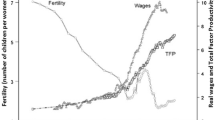Abstract
Industrialization allowed the industrialized world of today to escape from the Malthusian regime characterized by low economic and population growth and to enter the post-Malthusian regime of high economic and population growth. To explain the transition between these regimes, we construct a growth model with two consumption goods (an agricultural and a manufacturing good), endogenous fertility, and endogenous technological progress in the manufacturing sector. We show that with an exogenous increase in the growth of agricultural productivity our model is able to replicate stylized facts of the British industrial revolution. The paper concludes by illustrating that our proposed model framework can be extended to include the demographic transition, i.e., a regime in which economic growth is associated with falling fertility.
Similar content being viewed by others
References
Bailey, R. E., and M. J. Chambers. (1993). “Long-Term Demographic Interactions in Precensus England,” Journal of the Royal Statistical Society (Series A) 156, 339-362.
Baldwin, R. E., Martin, P., and G. I. P. Ottavio. (2001). “Global Income Divergence, Trade, and Industrialization: The Geography of Growth Take-Offs,” Journal of Economic Growth 6, 5-37.
Baumol, W. J. (1967). “Macroeconomics of Unbalanced Growth: The Anatomy of Urban Crisis,” American Economic Review 57, 415-426.
Birdsall, N. (1983). “Fertility and Economic Change in Eighteenth and Nineteenth Century Europe: A Comment,” Population and Development Review 9, 111-123.
Ciccone, A. (1997). “Falling Real Wages During an Industrial Revolution.” mimeo, University of Berkeley, CA.
Coale, A., and R. Treadway. (1986). “A Summary of the Changing Distribution of Overall Fertility, Marital Fertility, and the Proportion Married in the Provinces of Europe.” In A. Coale, and Watkins, S. (eds), The Decline of Fertility in Europe. Princeton, NJ: Princeton University Press.
Crafts, N. F. R. (1985). “Income Elasticities of Demand and The Release of Labor by Agriculture During the British Industrial Revolution: A further Appraisal.” in. Mokyr, J. (ed.), The Economics of the Industrial Revolution. Totowa, NJ: Rowman & Allanheld.
Dalgaard, C.-J., and C. T. Kreiner. (2001). “Is Declining Productivity Inevitable?” Journal of Economic Growth 6, 187-203.
Dyson, T., and M. Murphy. (1985). “The Onset of Fertility Transition,” Population and Development Review 11, 399-440.
Edwards, B. K., and R. M. Starr. (1987). “A Note on Indivisibilities, Specialization, and Economies of Scale,” American Economic Review 77, 192-194.
Ethier, W. (1982). “National and International Returns to Scale in the Modern Theory of International Trade,” American Economic Review 72, 533-544.
Galor, O., and O. Moav. (2001). “Natural Selection and the Origin of Economic Growth,” C.E.P.R. Discussion Paper No. 2727.
Galor, O., and D. N. Weil. (1996). “The Gender Gap, Fertility, and Growth,” American Economic Review 86, 374-87.
Galor, O., and D. N. Weil. (1999). “From Malthusian Stagnation to Modern Growth,” American Economic Review 89, 150-154.
Galor, O., and D. N. Weil. (2000). “Population, Technology, and Growth: From Stagnation to the Demographic Transition and Beyond,” American Economic Review 90, 806-828.
Goodfriend, M., and J. McDermott. (1995). “Early Development,” American Economic Review 85, 116-133.
Hansen, G. D., and E. C. Prescott. (2001). “Malthus to Solow,” mimeo, University of Minnesota, MN.
Helpman, E., and P. R. Krugman. (1985). Market Structure and Foreign Trade: Increasing Returns, Imperfect Competition, and the International Economy. Cambridge, MA: MIT Press.
Jones, C. I. (1999). “Growth: With or Without Scale Effects?” American Economic Review 89, 139-144.
Jones, C. I. (2001). “Was an Industrial Revolution Inevitable? Economic Growth Over the Very Long Run,” Advances in Macroeconomics 1(2), Article 1. http://www.bepress.com/bejm/advances/vol. 1/iss2/art1.
Kalemli-Ozcan, S. (2001). “Does Mortality Decline Promote Economic Growth?” Mimeo, University of Houston, TX.
Kelly, M. (2001). “Linkages, Thresholds, and Development,” Journal of Economic Growth 6, 39-53.
Kremer, M. (1993). “Population Growth and Technological Change: One Million B.C. to 1990,” Quarterly Journal of Economics 108, 681-716.
Lagerlöf, N.-P. (2001). “From Malthus to Modern Growth: Epidemics Explain the Three Regimes?” Mimeo, Concordia University, Montreal QC, Canada.
Lee, R. D. (1997). “Population Dynamics: Equilibrium, Disequilibrium, and Consequences of Fluctuations.” In Stark O., and Rosenzweig, M. (eds), The Handbook of Population and Family Economics (vol. 1B). Amsterdam: Elsevier.
Li, C.-W. (2000). “Endogenous vs. Semi-Endogenous Growth in a Two-R&D-Sector Model,” Economic Journal 110, 109-122.
Lucas, R. E. (1998). The Industrial Revolution: Past and Future. Mimeo, University of Chicago.
Maddison, A. (1991). Dynamic Forces in Capitalist Development: A Long Run Comparative View. Oxford and New York: Oxford University Press.
Malthus, T. R. (1798). An Essay on the Principle of Population. 1st ed. Reprint 1976, New York: Norton.
Matsuyama, K. (1992). “Agricultural Productivity, Comparative Advantage, and Economic Growth,” Journal of Economic Theory 58, 317-334.
Mitchell, B. R. (1988). British Historical Statistics. Cambridge, UK and New York: Cambridge University Press.
Nelson, R. R. (1956). “A Theory of the Low Level Equilibrium Trap in Underdeveloped Economies,” American Economic Review 46, 894-908.
Office for National Statistics. (1998). The Health of Adult Britain. CD-rom.
Rostow, W. W. (1960). The Stages of Economic Growth: A Non-Communist Manufesto. Cambridge, UK and New York: Cambridge University Press.
Sorensen, A. (1999). “R&D, Learning, and Phases of Economic Growth,” Journal of Economic Growth 4, 429-445.
Steinmann, G., A. Prskawetz, and G. Feichtinger. (1998). “A Model on the Escape from the Malthusian Trap.” Journal of Population Economics 11, 535-550.
Wrigley, E. A., and R. S. Schofield. (1981). The Population History of England 1541–1871, A Reconstruction. Cambridge, MA: Harvard University Press.
Young, A. (1998). “Growth Without Scale Effects,” Journal of Political Economy 106, 41-63.
Author information
Authors and Affiliations
Rights and permissions
About this article
Cite this article
Kögel, T., Prskawetz, A. Agricultural Productivity Growth and Escape from the Malthusian Trap. Journal of Economic Growth 6, 337–357 (2001). https://doi.org/10.1023/A:1012742531003
Issue Date:
DOI: https://doi.org/10.1023/A:1012742531003




